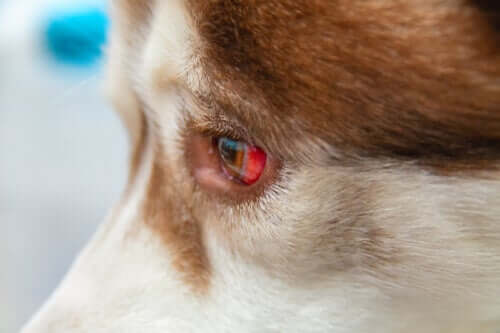Eye Spills in Dogs and How to Treat Them

Eye spills in dogs are more common than you may think, and knowing how to treat them is our responsibility. This means dog owners need to be informed, and that’s what we want to talk about today.
What are eye spills in dogs?
Eye spills (or subconjunctival hemorrhages) are lesions in a dog’s eye that may result from a blow to the eye. In other words, they can be the result of an object hitting a dog’s eye without actually penetrating it. This causes visible bleeding inside the eye.
Depending on the strength of the blow to a dog’s eye, this can produce changes in its formation. For example, it can cause lens displacement, detached retina, and fracturing of the bones around the eye. In fact, it can even cause the eyeball to collapse, causing complete vision loss in the affected eye.
In other cases, eye spills in dogs result from a sharp object that does, in fact, penetrate the eye. This is not as uncommon as you think, since dogs are exposed to branches and thorns on plants, for example. Other pets, such as cats, can also hurt a dog’s eye with their claws. Even the wind can blow a foreign object in your dog’s eye and cause injury. Any of these situations can cause perforation of the eye, leading to major damage.
Which dogs are more prone to suffering eye spills?
There’s no particular age or specific breed that’s more likely to experience subconjunctival hemorrhage. However, there are certain circumstances that put dogs at greater risk. For example, work dogs and hunting dogs are both more prone to suffer from eye trauma than other dogs.

Puppies, given their inexperience and curiosity, are also at risk. They can easily get themselves into trouble and walk through places that expose them to danger. Dogs that are in heat may do the same thing, given their desperate need to find a bitch to mate with.
How to know if my dog has an eye spill
Eye spills in dogs don’t always present themselves immediately. Therefore, it’s important to keep our pets under close observation. These are some of the signs that will help you effectively determine if your dog is suffering from an eye spill:
- Increased blinking
- Mild bleeding of the eye or eyelid
- Excessive tearing
- Bruises on the dog’s face or head
- Red eyes
- Swelling of the third eyelid
- Cloudy cornea
- Your dog insists on touching its eye with his paw
- In more serious cases, closed eyelids
- Ocular secretions
- Your dog won’t let you touch their head
- Changes in eye color
- Changes in the shape of your dog’s eye
Any of these signs will let you know that something is wrong and that, without a doubt, you need to take action. There’s no better option than to take your dog to receive urgent medical care. A veterinarian will make a diagnosis and propose a treatment plan. Treatment may include medication or eye surgery, depending on the seriousness of your dog’s injury.
Post-treatment care
Post-treatment care is important for your canine’s recovery. And dog owners play a major role in this process, since you will need to follow your veterinary’s instructions to a tee.
Prevent your dog from touching the injury at all costs by placing an e-collar on his neck. If you notice any changes, go back to the vet. Be sure to clean the eye as recommended by the veterinarian, and follow any other instructions for your dog’s care.
Remember that no dog is exempt from suffering from eye spills. But, as owners, it’s our responsibility to keep the situation from becoming worse and having serious consequences, such as total vision loss.
All cited sources were thoroughly reviewed by our team to ensure their quality, reliability, currency, and validity. The bibliography of this article was considered reliable and of academic or scientific accuracy.
- Gallego-Mejía, M., Giraldo-Villegas, J. C., Correa-Salgado, R. A., & Delgado-García, L. M. (2010). Prolapso de glándula del tercer párpado en caninos atendidos en el Hospital Veterinario de la Universidad de Caldas. vet. zootec, 4(1), 36-41.